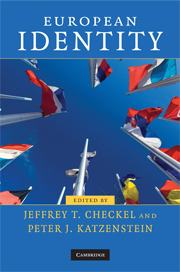Book contents
- Frontmatter
- Contents
- List of figures
- List of tables
- List of contributors
- Preface
- 1 The politicization of European identities
- Part I European identity as project
- Part II European identity as process
- 5 Being European: East and West
- 6 Who are the Europeans and how does this matter for politics?
- 7 Immigration, migration, and free movement in the making of Europe
- Part III European identity in context
- Bibliography
- Index
5 - Being European: East and West
Published online by Cambridge University Press: 05 June 2012
- Frontmatter
- Contents
- List of figures
- List of tables
- List of contributors
- Preface
- 1 The politicization of European identities
- Part I European identity as project
- Part II European identity as process
- 5 Being European: East and West
- 6 Who are the Europeans and how does this matter for politics?
- 7 Immigration, migration, and free movement in the making of Europe
- Part III European identity in context
- Bibliography
- Index
Summary
This essay traces events and ideas that have blurred the boundary between supranational and national conceptions of European identity, starting with the French Revolution and its ideological and geopolitical progeny. The essay is organized thematically, so following a section on “Foreground and background” are “Revolution and counter-revolution,” “Nation and supra-nation,” and “Remembering and forgetting.” Although the themes are paired opposites, the analysis shows how readily the oppositional character of the words breaks down under the pressure of historical contextualization. This notion of opposites in name only – a perception of difference that masks a profound similarity – is one that extends to the pair of opposites that appear in the title of this chapter; namely “East and West.”
Modern conceptions of European identity formed during the course of wars, revolutions, and utopian political projects that both “halves” of Europe experienced and interpreted in very localized ways, increasingly within national historical frameworks. This evolution made for disagreements regarding the nature of “universal” European values and projects between “East” and “West.” But if we pull back the curtain of false oppositions, we begin to see the outlines of a structural similarity in the way “Europeanness” is understood. The similarity rests on the premise that being “European” is not only compatible with being “national,” but is a constituent element of national identity.
- Type
- Chapter
- Information
- European Identity , pp. 111 - 131Publisher: Cambridge University PressPrint publication year: 2009
- 20
- Cited by

